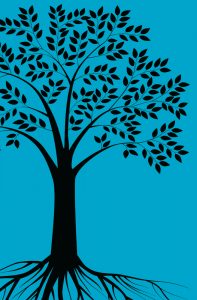The sages of Ayurveda teach the world, perhaps her first amazingly perceptive lesson in environmental science, that air quality, water, soil and time – these four universals and their mutual interaction, is vital enough to cause widespread havoc when disrupted. In such a case, thousands of individuals can be simultaneously destroyed by one disease, and this mass annihilation of humanity through epidemics is termed as janapadodhwansa.
Further, the sages grimly point the fingers back at us humans as the ultimate cause of the imbalance; and our inconsiderate, self-serving, exploitative and short-sighted actions that indicate dharma or loss of all that is right and noble. This ultimately leads to the upset of natural laws and nature’s fragile balance. Over time, earth’s natural environment, instead of protecting us and working for earth’s creatures and our unique requirements, becomes a breeding house of disasters; the sun and the moon behave unpredictably; the seasons change course; and diseases thrive and multiply.
Life in a bottle
Charaka, Ayurvedic sage and scholar, enumerates details on health management when either or all four factors are simultaneously disturbed. An ancient Ayurvedic text, Charaka Samhita, expresses points of concern in this regard, “There are observed the abnormal condition of stars, planets, moon, sun, air, fire and also of the environment which (in turn) derange the seasons too.” The text highlights the fact that deranged cosmological and environmental factors will ultimately end up disturbing the quality of food and herbs and their medicinal properties.

Charaka advises human beings on the management of environment by inquiring into the quality of air, water, land and time. According to the sage, air that blows not in accordance with season, or blows excessively, or is too moist, too cold, too hot, too rough, too speedy, with terrible howling sounds or whistling sounds, excessively clashing with each other, affected with unsuitable smells, polluted with vapor, smoke or dust and even carrying small suspended particles, is considered as a destroyer of health and life. He cautions that water that has been deserted even by aquatic birds and animals should not be consumed (even after purification). Polluted water carries smell, color, taste and is sometimes even slimy to touch. It should be avoided at all costs.
Time, according to Charaka, should be taken as unwholesome when it is having signs contrary, excessive, or deficient to those of the seasons. Abnormal rainfall or no rainfall, excessive thermal warming, and man made droughts are all signs of disturbed time.
With astuteness, the sages mention the factors that can disturb the quality of land in which humans reside. These factors are not only natural ones such as frequent earthquakes, tendency to flood, excessive rainfall, being run over by wild animals, reptiles or killer insects like mosquitoes and locusts, but also man made such as when land is polluted by the attitude and values of the humans who reside there.
Ayurvedic texts mention that one should stay away from communities that have abandoned and destroyed virtue as an ideal, that is, dharma has been discarded as a social and personal ideal of the inhabitants, and instead, a free-for-all state of affair now exists.

Charaka cautions that water that has been deserted even by aquatic birds and animals should not be consumed (even after purification).
Loss of Dharma affects environment
Ayurveda conceives a dynamic and animated model of this universe where all objects, beings, events, phenomena and experiences are inter-connected and vitally linked to each other. In such a mutually interactive state of affairs, human will and action impact not only the immediate sphere of influence but also the condition of the environment and actually extend to agitate the entire cosmos.
According to Ayurveda, when we humans choose to discard truthfulness, modesty and righteousness (dharma) the entire cosmos becomes agitated. Charaka declares unequivocally, “The root cause of the derangement of wind (vayu), etc. is loss of dharma or unrighteousness.” Rivers become violent and change course, meteorites appear frequently, earthquakes shake the terrain and even the sun, moon and stars become enraged.

Ayurveda regards epidemics and natural catastrophes as the loss of equilibrium of the universal counterparts of the bodily doshas – Vata, Pitta and Kapha, which are Vayu (Air), Agni (Fire) and Soma (Water), or to go still further, the three metaphysical forces or fundamental vibrations – Rajas, Sattva and Tamas.
Our “inner” violence or non-dharmic thoughts and actions towards each other, towards other species, and our abusive dealing with nature, are tantamount to the disturbance of gunas (vibrations in consciousness) which then carry over to rock our “outer” world which is our immediate environment. These vibrations, especially when an entire body of humans collectively vibrate it, they echo out in time to affect even the outer space, disrupting the “dharma” and flow of heavenly bodies like planets, stars and meteors, etc.
Today, the list of environmental issues due to “short-sighted” human activities is growing exponentially, and includes:
Anoxic waters:
• Anoxic event
• Hypoxia
• Ocean De-oxygenation
• Dead zone
Climate change:
• Global warming
• Global dimming
• Fossil fuels
• Sea level rise
• Greenhouse gas
• Ocean acidification
• Shutdown of thermohaline circulation
Conservation:
• Species extinction
• Pollinator decline
• Coral bleaching
• Holocene
extinction
• Invasive species
• Poaching
• Endangered species
Energy:
• Energy conservation
• Renewable energy
• Efficient energy use
• Renewable
•energy commercialization
Environmental degradation:
• Eutrophication
• Habitat destruction
• Invasive
• species
Environmental health:
• Air quality
• Asthma
• Electromagnetic fields
• Electromagnetic radiation and health
• Indoor air quality
• Lead poisoning
• Sick
•Building Syndrome
Genetic engineering:
• Genetic pollution
• Genetically modified food controversies
Intensive farming:
• Overgrazing
• Irrigation
• Monoculture
• Environmental effects of meat production
• Slash and burn
• Pesticide drift
• Plasticulture
Land degradation:
• Land pollution
• Desertification
Soil:
• Soil conservation
• Soil erosion
• Soil contamination
• Soil salination
Land use:
• Urban sprawl
• Habitat fragmentation
• Habitat destruction
Nanotechnology:
• Nanotoxicology
• Nanopollution
Nuclear issues:
• Nuclear fallout
• Nuclear meltdown
• Nuclear power
• Nuclear weapons
• Nuclear and radiation accidents
• Nuclear safety
• High-level radioactive
• waste management.
Overpopulation:
• Burial
• Water crisis
• Overpopulation in companion animals
• Tragedy of the commons
Ozone depletion:
•CFC
Pollution:
• Light pollution
• Noise pollution
• Visual pollution
• Nonpoint source
• pollution
• Point source pollution
Water pollution:
• Acid rain
• Eutrophication
• Marine pollution
• Ocean dumping
• Oil spills
• Thermal pollution
• Urban runoff
• Water crisis
• Marine debris
• Ocean acidification
• Ship pollution
• Wastewater
• Fish kill
• Algal bloom
• Mercury in fish
Air pollution:
• Smog
• Tropospheric ozone
• Indoor air quality
• Volatile organic compound
• Particulate matter
• Sulphur oxide
Reservoirs:
• Environmental impacts of reservoirs
Resource depletion:
• Exploitation of natural resources
• Overdrafting
Consumerism:
• Consumer capitalism
• Planned obsolescence
• Over-consumption
Fishing:
• Blast fishing
• Bottom trawling
• Cyanide fishing
• Ghost nets
• Illegal
• unreported and unregulated fishing
• Overfishing
• Shark finning
• Whaling
Logging:
• Clearcutting
• Deforestation
• Illegal logging
Mining:
• Acid mine drainage
• Mountaintop removal mining
• Slurry impoundments
Toxins:
• Chlorofluorocarbons
• DDT
• Endocrine disruptors
• Dioxin
• Toxic heavy metals
• Herbicides
• Pesticides
• Toxic waste
• PCB
• Bioaccumulation
• Biomagnification
Waste:
• E-waste
• Litter
• Waste disposal incidents
• Marine debris
• Medical waste
• Landfill
• Leachate
• Recycling
• Incineration
• Great Pacific Garbage Patch
Today, our world is indeed ravaged by epidemic disease, toxins, addictions, and pollutants. All creatures, including us humans, have become victims of increasing natural disasters, calamities, and ravages of time and technology. Even the frequency of earthquakes, floods, tornadoes and hurricanes has increased all over the globe.
In his ultra modern vision, ancient Vedic sage Charaka traces seasonal vagaries and untimely disruption of seasonal rhythms to the generally non-dharmic approach including anti-environmental and anti-nature policies adopted by short-sighted governments, and their imprudent heads and administrators.
In fact the general unrighteousness adopted by governments and their administrations the world over, serves to promote and even encourage a pervasive atmosphere of free-for-all unrighteousness so that even traders or commercial interests jump into the mayhem. Soon, everyday common folks also get caught up in the ensuing rat race and destruction of goodness. In Charaka’s words, “Thus, this unrighteousness by force makes the righteousness disappear.”
He declared that communities (such as our current human society in the 21st century, ravaged by above environmental issues) are soon deserted, even by Gods! He writes, “And because of this, it does not rain in time, or at all; or there is abnormal rainfall; winds do not blow properly; the land is affected; water reservoirs get dried up; and the herbs (medicines) giving up their natural properties acquire morbidity. Then epidemics break out due to polluted contacts and edibles.”
I have come to a realization that human life is very powerful. Even a single life, yours or mine, has the power to tug at the planets, stir up the clouds, beckon rains, propel mountains and stop everything dead in its track…if our consciousness so decides.
We live our life not only in nature. We also live in a community of people and our other environment is made up of people – white, black, yellow, and brown in color. Yes, this entire globe with its various pockets of communities of people is our social environment. And what do we find here except more mutilation by inner and outer war and communities and countries spilling over with mistrust and confusion? Charaka clearly proclaims, “Likewise, unrighteousness or a-dharma is also the cause of the destruction of community by weapons. Those (communities and their leaders) who have excessively increased greed, anger, attachment and conceit; disregarding the weak, (either) attack each other, or their enemies, or are attacked by their enemies resulting in loss of themselves, their kinsmen and enemies.”

In the environment, be it natural, social, psychological, or spiritual – vibration begets vibration. Before we bothered to speak up, what was the message vibrating away in our quiet silence? Before we proclaimed to ourselves and to the world that we are victims, what about that vibration of subtle aggression that we repeatedly sent out earlier? Before we briskly rise ourselves and passionately rouse others to defend us and our petty self-serving causes, our nation, our ideologies and our religion, (our social environment), should we not first take account of the offending vibrations that we dumped earlier?
Thus, the Ayurvedic sages offered a deeply insightful understanding of our divine life which is really the manifestation of the relationship between macrocosm (environment) and microcosm (human being). In the end only dharma prevails. This said, the Ayurvedic sages offered health to the living and breathing planet earth and then to the entire cosmos by suggesting measures which would guide the human consciousness to walk only the path of dharma or righteousness, none other. This ensures the quality of gunas (vibration) that we the people, as a collective entity, send out.
Ayurveda’s path of Dharma
Ayurveda has constantly emphasized all through these centuries that we humans, collectively and individually, should learn to live in harmony with ourselves, with nature and all its beings. Charaka declares, “One should behave like kith and kin to all living beings.”

He suggests that to promote righteousness all around one should work upon cultivating qualities such as truthfulness, benevolence, compassion, spirit of charity and generosity, practicing staying calm in all situations, exercising restraint in sexuality, and of course protecting the self as self-love is the core of evolved consciousness. Additionally, to train the mind, Charaka suggests seeking the company of celibate sages, listening to their evolved discourses, and self study of scriptures is recommended on a daily basis.
Ayurvedic sage Charaka explains that seeing the entire universe in the self and vice versa gives rise to true knowledge, “When one thinks of himself spread in the universe and vice versa, and has the vision of the great and the small (mundane affairs); his serenity based on knowledge is not affected.” He further explains that after realizing this intimacy of self with universe, such a person, not only gleams the spiritual truth and experiences joy and bliss, but also, as a citizen of our earth, begins to deeply respect his/her natural environment and fellow creatures with whom this wonderful earth is to be shared with.
This sense of oneness, removes all illusions of separation, and the abuse and misuse that stems from a perception of “separation” also ends, naturally and permanently. The limited ego with its desire to exploit and mindlessly utilize the natural resources for its own selfish continuity is submerged in an ocean of unity consciousness that makes one take care of a random rock from the river, in the same way as one would take care of one’s own body.
Where is the scope of abusing the environment now? Through spiritual vision, one has the potential of becoming a deeply respectful being, dwelling in profound harmony with all of nature and her creatures. This is true health. This is the health guaranteed by the sages of Ayurveda, only if, we pause and see and understand what the sages are telling us, and take responsibility towards restoring dharma in our dealings with each other and our environment.
An inner awakening
Ayurveda awakens the powers to heal ourselves within each one of us. If this life is an extension of nature, then why not use nature to be the best we can? Why be at war with nature? Why be suspicious of nature? Why not embrace our natural environment with both hands and find ourselves lost in its compassionate embrace? Ayurveda teaches peace with the internal forces that regulate body and mind, and a peaceful relationship with the external elements that compose our environment.
Ayurveda is indeed based upon remembering, reconnecting, and celebrating the eternal harmony and sacred connections between man and nature. Followers of Ayurveda begin to discover the deep nurturance ever available in nature, and gradually become one with the great cycle and rhythm of nature. It all begins with respecting nature and understanding the basic truth that we and our environment are one, we are each other’s extension, and disrespecting or disregarding one, leads to injury of the other.

Ayurveda’s prescription: all natural life
Ayurveda supports a non-polluted, clean, pure environment and deep respect for the natural web of codependence and co-respect between man and his universe. Due to Ayurveda’s deep belief and respect of nature, correctly prepared Ayurvedic medicine is totally natural, eco-friendly, and utilizes 100 percent, biodegradable, “life and environment friendly” ingredients as its tools for healing. Ayurveda promotes a life in which humans interact with nature in a most natural manner, as a child would play in his mother’s lap.
Thus, the science of Ayurveda from ancient India, colors our life with the color of nature – Green. It is no wonder that Ayurveda, the original healing science of mankind, counsels us humans to always restore the natural equilibrium between us and our environment, and bring respect into our relationship with all living creatures that inhabit our wonderfully alive, interconnected and dynamic environment.
 Hailing from a lineage of Vedanta sages in India, Acharya Shunya is an Ayurveda pioneer, master healer, mystic teacher, and published author. She founded the Vedika Global Foundation in Berkeley, California. She leads Ayurvedic workshops and retreats throughout the US and India. Acharya Shunya is known for her unique way of expressing Ayurveda in conjunction with Advaita Vedanta and Yoga. acharyashunya.com
Hailing from a lineage of Vedanta sages in India, Acharya Shunya is an Ayurveda pioneer, master healer, mystic teacher, and published author. She founded the Vedika Global Foundation in Berkeley, California. She leads Ayurvedic workshops and retreats throughout the US and India. Acharya Shunya is known for her unique way of expressing Ayurveda in conjunction with Advaita Vedanta and Yoga. acharyashunya.com







